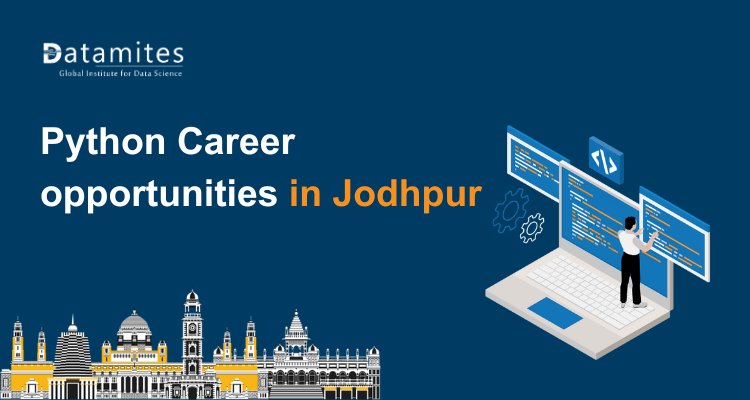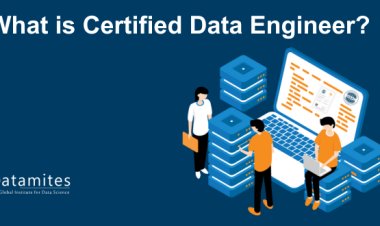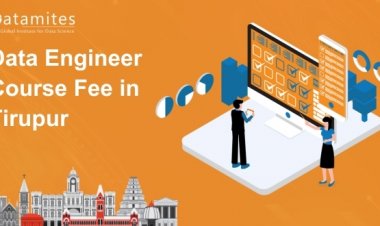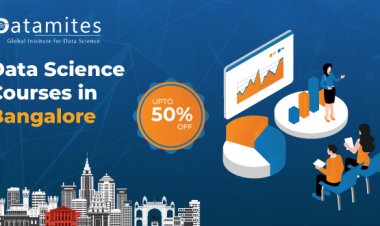How to Learn Machine Learning from Scratch?
Learning machine learning from scratch can be an exciting journey for beginners, even without a technical background. The process starts with understanding fundamental concepts such as statistics, linear algebra, and programming especially in Python.
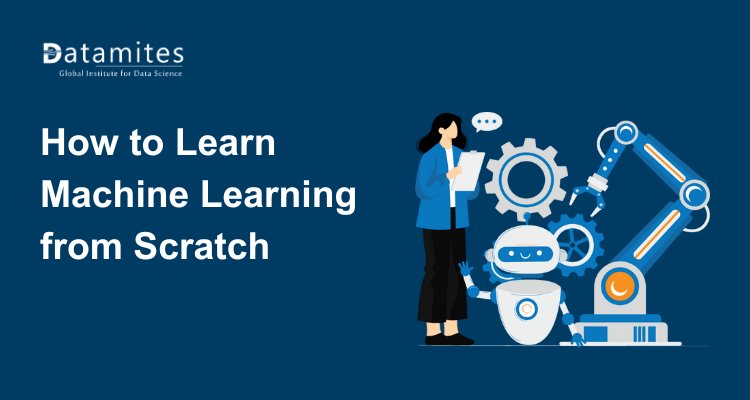
Have you ever wondered how machines can recognize faces, recommend your next favorite song, or even predict the stock market? That’s the magic of Machine Learning and guess what? You don’t need a Ph.D. to get started. Whether you're a curious beginner, a career switcher, or someone fascinated by the buzz around AI, learning Machine Learning from scratch is absolutely possible. With the right roadmap and mindset, you can go from zero to building real-world ML models that make a real impact. Ready to unlock the secrets behind the tech shaping our future?
What is Machine Learning?
Machine Learning is a branch of Artificial Intelligence (AI) that enables computers to learn from data and make decisions or predictions without being explicitly programmed for specific tasks. Instead of writing rules for every possible situation, we train a machine learning model with examples, and the model learns patterns from that data.
Types of Machine Learning
Machine Learning is a powerful branch of artificial intelligence that enables systems to learn and make decisions from data without being explicitly programmed. It is broadly categorized into three main types: Supervised Learning, Unsupervised Learning, and Reinforcement Learning.
1. Supervised Learning
Definition: Supervised learning is where the model is trained on a labeled dataset, meaning that the input comes with the correct output. The goal is to learn a mapping from inputs to outputs.
How it works:
- You feed the model input data (features) and the corresponding correct answer (label).
- The model learns from the data and makes predictions.
- It is then corrected by comparing the predictions to the actual output.
Algorithms used:
- Linear Regression
- Logistic Regression
- Decision Trees
- Support Vector Machines (SVM)
- Random Forest
- Neural Networks
2. Unsupervised Learning
Definition: Unsupervised learning is used when the dataset has no labels. The goal is to find hidden patterns or structure in the data.
How it works:
- The model tries to learn the underlying structure by grouping or organizing the data.
- There is no correct output provided; it’s more about exploration.
Algorithms used:
- K-Means Clustering
- Hierarchical Clustering
- Principal Component Analysis (PCA)
- Association Rule Mining
3. Reinforcement Learning
Definition: Reinforcement learning is a type where an agent learns to make decisions by interacting with an environment, receiving rewards or penalties.
How it works:
- The agent takes actions in an environment.
- It gets feedback in the form of rewards (positive) or punishments (negative).
- The goal is to maximize cumulative reward over time.
Key Concepts:
- Agent
- Environment
- Policy
- Reward
- Value Function
Refer these below articles:
- Understanding Machine Learning: Basics for Beginners
- The Importance of Feature Engineering in Machine Learning
- Getting Started with Machine Learning
Why is Learning Machine Learning Important in Today’s Data-Driven World?
In today’s digital age, data is generated everywhere from social media and online shopping to healthcare systems and smart devices. We produce trillions of bytes of data every day, and Machine Learning plays a crucial role in making sense of it all. By learning ML, individuals and organizations gain the ability to transform raw data into actionable insights, accurate predictions, and intelligent decision-making. Currently, 42% of IT professionals at large organizations report having actively deployed AI, while an additional 40% are actively exploring its implementation.
1. Data is the New Fuel, and ML is the Engine
Organizations are collecting massive amounts of data, but without intelligent analysis, it's just noise. Machine Learning helps transform raw data into actionable insights, making it the engine that drives innovation, automation, and informed decision-making.
2. Ubiquity of ML in Everyday Life
ML powers the tech we use daily—whether it's personalized Netflix recommendations, voice assistants like Alexa, or Google Maps optimizing your route in real time. Understanding ML gives you insights into the technology that shapes modern life.
3. High Demand and Career Opportunities
The demand for professionals with ML skills is skyrocketing. Roles like Data Scientist, ML Engineer, and AI Specialist are among the highest-paying and fastest-growing careers worldwide.
4. Business Optimization and Innovation
From predictive maintenance in manufacturing to fraud detection in banking, ML is helping businesses cut costs, improve efficiency, and innovate. Learning ML enables you to contribute meaningfully to these transformations.
5. It Empowers Problem Solvers and Creators
Whether you’re a student, developer, or entrepreneur, ML gives you tools to solve real-world problems creatively—from diagnosing diseases to automating customer support or even building intelligent robots.
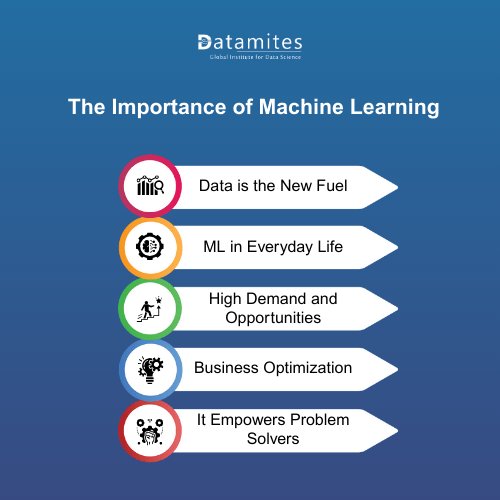
Prerequisites Before Starting Machine Learning
Before diving into the world of Machine Learning, it’s essential to build a strong foundation. You don’t need to be an expert in every technical area, but having a solid understanding of key concepts will make your ML journey much smoother and more meaningful.
Basic Mathematics You Should Know (Linear Algebra, Calculus, Probability)
Mathematics is the backbone of machine learning algorithms. Here's why each area matters:
- Linear Algebra: Essential for understanding data structures like vectors, matrices, and tensors, which are fundamental in building ML models. Concepts such as matrix multiplication, eigenvectors, and vector spaces are often used in deep learning and optimization problems.
- Calculus: Especially differential calculus, is crucial for understanding how learning algorithms update themselves. Gradient descent—a key optimization technique in ML—relies on derivatives to minimize error.
- Probability and Statistics: Machine Learning often deals with uncertainty and decision-making under unknown conditions. Probability helps models make predictions, while statistics helps in understanding and interpreting data distributions and outcomes.
Programming Language Essentials (Why Python is Preferred)
You don’t have to be a software engineer, but a basic understanding of programming is vital. Here's why Python is the top choice:
- Simple and Readable Syntax: Python is beginner-friendly, which allows you to focus on learning ML concepts without getting bogged down by complex code.
- Powerful Libraries: Python boasts a vast ecosystem of ML libraries such as scikit-learn, TensorFlow, Keras, PyTorch, and pandas—tools that drastically simplify the development process.
- Strong Community Support: Python has one of the most active developer communities, which means more tutorials, open-source projects, and community help as you learn.
Understanding Data and Its Importance in ML
- At its core, Machine Learning is data-driven. Your model’s performance depends heavily on the quality and relevance of the data you feed it. Key points to understand include:
- Types of Data: Learn the difference between structured vs. unstructured data, categorical vs. numerical features, and how to handle missing or noisy data.
- Data Preprocessing: Before feeding data into an ML model, you often need to clean, normalize, and transform it. This step can drastically affect model accuracy.
- Exploratory Data Analysis (EDA): This involves visualizing and summarizing datasets to discover patterns, spot anomalies, and form hypotheses. It’s a critical skill before model training.
Step-by-Step Guide to Learning Machine Learning
Starting your machine learning journey can seem overwhelming at first, but breaking it down into clear, manageable steps can make the process both structured and enjoyable. By following a step-by-step roadmap, you can progress from a complete beginner to confidently building real-world machine learning models.
Growing at a Compound Annual Growth Rate (CAGR) of 30%, the AI software market size will reach US$391.43 billion in 2030.(ABI Research). Now is the perfect time to dive into the world of machine learning and be part of this transformative revolution.
Step 1: Learn the Fundamentals of ML
Before you start coding, it’s essential to understand the foundational concepts that drive machine learning.
Types of Machine Learning
- Supervised Learning: The model learns from labeled data. Common tasks include classification (e.g., spam detection) and regression (e.g., predicting house prices).
- Unsupervised Learning: The model identifies patterns in data without labels. Techniques like clustering and dimensionality reduction are used here.
- Reinforcement Learning: The model learns by interacting with an environment, receiving rewards or penalties for its actions (e.g., game-playing AI, robotics).
Key Terminology
- Features: The input variables or attributes used to make predictions.
- Labels: The output or target variable you're trying to predict (only in supervised learning).
- Training: The phase where the model learns from the data.
- Testing: Evaluating the model's performance on unseen data.
- Overfitting/Underfitting: Common pitfalls where a model either learns the data too well (overfitting) or not well enough (underfitting).
Step 2: Learn Python and Essential Libraries
Python is the most widely-used language in ML, thanks to its readability and strong ecosystem.
Tools and Libraries to Know
- NumPy: For numerical computations and handling arrays.
- Pandas: For data manipulation and analysis.
- Matplotlib / Seaborn: For data visualization.
- Scikit-learn: A beginner-friendly library for implementing classical ML algorithms.
Writing Your First ML Program
Start with a simple program—such as using Scikit-learn to create a Linear Regression model. It helps you understand the end-to-end flow: importing libraries, loading data, training the model, and evaluating results.
Step 3: Study Machine Learning Algorithms
Now it’s time to get hands-on with the algorithms that power ML models.
Popular Algorithms to Learn
- Linear Regression: For predicting continuous values.
- Logistic Regression: For binary classification tasks.
- Decision Trees & Random Forests: For interpretable models and ensemble learning.
- Support Vector Machines (SVMs): Effective in high-dimensional spaces.
- K-Nearest Neighbors (KNN): A simple algorithm based on proximity.
- Clustering (e.g., K-Means): For finding hidden groupings in data.
Hands-on Examples and Visualizations
Visualize how decision boundaries change with different algorithms. Use datasets like Iris or Titanic to experiment and reinforce concepts.
Step 4: Work on Real-World Projects
Theory is great, but projects are where the real learning happens.
Dataset Sources
- Kaggle: Offers datasets and a community to share and learn.
- UCI Machine Learning Repository: A classic source for curated datasets across domains.
- Google Dataset Search: Great for discovering niche datasets.
Mini Projects for Beginners
- Predict house prices using regression.
- Classify spam emails using NLP.
- Identify handwritten digits (MNIST dataset).
- Cluster customer segments in marketing data.
Working on projects helps you understand how to clean data, engineer features, and handle practical challenges.
Step 5: Practice on ML Platforms
To become proficient, practice consistently on interactive platforms.
Use Google Colab or Jupyter Notebooks
These tools let you run Python code directly in your browser, with no setup. Google Colab even offers free GPU access for training more complex models.
Join Online Competitions
- Kaggle Competitions: Compete with others to solve real business problems using ML.
- DrivenData: Social impact ML challenges.
- Zindi: Africa-focused data science challenges with global relevance.
Competitions sharpen your skills, expose you to new techniques, and help build a strong portfolio.
Read these below articles:
Machine Learning is no longer limited to researchers or tech giants; it's accessible to anyone with the curiosity to explore what’s next. With consistent effort, a willingness to learn, and practical hands-on experience, you can master ML from the ground up and create impactful solutions that shape the future. According to Grand View Research, the global artificial intelligence industry is projected to reach a revenue of USD 1,811,747.3 million by 2030, growing at a compound annual growth rate (CAGR) of 35.9% from 2025 to 2030. Working on collaborative projects also helps you gain experience with version control, code documentation, and team-based workflows skills that are vital in professional environments.
The market for artificial intelligence grew beyond 184 billion U.S. dollars in 2024, a considerable jump of nearly 50 billion compared to 2023. This staggering growth is expected to continue with the market racing past 826 billion U.S. dollars in 2030 (Statista Reports). Whether you're looking to launch a new career or apply ML in your field, now is the perfect time to begin your journey.
DataMites offers a wide array of courses designed to cater to various proficiency levels, from beginners to advanced professionals. These courses are structured to provide both theoretical knowledge and practical experience, often incorporating live projects and internship opportunities to enhance real-world applicability. As an authorized training partner of the IABAC and NASSCOM FutureSkills, DataMites ensures that its certifications are globally recognized.
Understanding the diverse needs of learners, DataMites offers an Machine Learning Course in Bangalore with flexible learning modes to suit various preferences and schedules. These include classroom training at multiple locations for those who prefer in-person interaction and hands-on guidance; online training with live virtual classes that provide an interactive and engaging experience from anywhere; and self-paced learning, ideal for individuals who wish to study independently at their own pace.
The Machine Learning Training in Chennai is a comprehensive and globally recognized program designed to equip learners with in-depth knowledge and practical skills in AI and its subfields. DataMites also offers strong career support to ensure participants are well-prepared for job opportunities in the AI industry. This includes personalized resume building to effectively showcase skills and experience, mock interviews conducted by industry experts with valuable feedback, and regular updates on job openings and interview opportunities.


